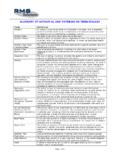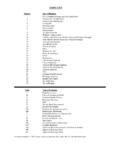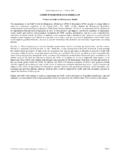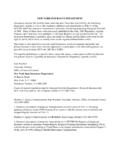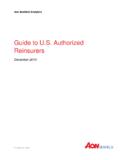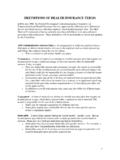Transcription of GLOSSARY OF REINSURANCE TERMINOLOGY - …
1 Page 1 of 18 GLOSSARY OF REINSURANCE TERMINOLOGY Term Definition Accident Year Experience REINSURANCE experience calculated by matching the total value of all losses occurring during a 12-month period with premiums earned for the same period. Acquisition Costs All expenses directly related to acquiring insurance or REINSURANCE accounts; normally the commission paid to the REINSURANCE company as an offset against its agent s commission, premium taxes and other costs of doing business; includes REINSURANCE brokers commission where applicable. Admitted REINSURANCE (Authorized REINSURANCE ) REINSURANCE for which credit is given for the unearned premiums and unpaid claims in a ceding company s Annual Statement because the REINSURANCE is placed in an admitted REINSURANCE company and is licensed to transact business in the jurisdiction in question.
2 Admitted Assets Assets recognized and accepted by state departments of insurance when determining the solvency of insurers or reinsurers. Adverse Selection (Anti-Selection, Selection of Risk) The conscious and deliberate cession of those risks, segments of risk, or coverages that appear less attractive for retention by the ceding company; the practice of ceding poorer business to the reinsurer while retaining the better business. Aggregate The dollar amount of REINSURANCE coverage during one specified period, usually 12 months, for all REINSURANCE losses sustained under a treaty during such period. Aggregate Excess REINSURANCE Treaty (Stop Loss Treaty, Aggregate Excess of Loss REINSURANCE or Excess of Loss Ratio REINSURANCE ) A form of REINSURANCE where the reinsurer indemnifies the ceding company for the amount by which the ceding company s aggregate losses of a specified class of business exceed a specified loss ratio or a specified dollar amount; used primarily in classes of insurance with wide fluctuation in losses from year to year, such as hail insurance.
3 Aggregate Extension Clause Stipulates that all aggregate original policies will attach on a risk incepting during the period basis, and describes a manner in which attachment date of a policy or policies is determined; determines how the aggregate is calculated in the event that one loss affects more than one policy or more than one insured; applies to casualty excess of loss business only. Aggregate Working Excess (Aggregate Annual Deductible) A form of per risk excess REINSURANCE under which the primary company retains its normal retention on each risk and additionally retains an aggregate amount of the losses which exceeds normal retention. Alien Company An insurer or reinsurer domiciled outside the but who is conducting insurance or REINSURANCE business in the Alternative Risk Mechanism A method of financing primary property and/or casualty losses without using traditional insurers to assume risk in the primary layer; two principal types of alternative risk mechanisms are self-insurance and captive insurance companies.
4 Annual Aggregate Deductible A provision in excess of loss REINSURANCE contracts stipulating that the ceding company will retain, in addition to its retention per risk or per occurrence, an annual aggregate amount of loss that would otherwise be recoverable from the reinsurer; expressed as a dollar amount or a percentage of the ceding company s subject premium for the annual period; caps the amount of loss the insured may be required to pay before the insurance responds. Annual Statement (Statutory Annual Statement, Convention Blank) The annual report format prescribed by the NAIC and the state departments of insurance; provides a summary of the company s financial operations for a calendar year, including a balance sheet supported by detailed exhibits and schedules; is filed with the state insurance department of each jurisdiction in which the company is licensed to conduct business.
5 Page 2 of 18 Term Definition Arbitration Clause Language providing an alternative dispute resolution forum to resolve differences between the reinsurer and the ceding company without litigation. As If A term used to describe the recalculation of prior years of loss experience to demonstrate what the underwriting results of a particular program would have been as if the proposed program had been inforce during that period. Assumed Portfolio (Return Portfolio) The transfer of in-force insurance liability by an insurer to a reinsurer by the payment of the unearned premiums reserve on those policies alone, or by the concurrent transfer of liability for outstanding losses under those policies by the payment of the outstanding loss reserve by the insurer to the reinsurer; the former is a premium portfolio, the latter a loss portfolio. Assumption Certification (Cut Through Clause, Strike-Through Clause) Type of insolvency clause providing that in the event of insolvency of a ceding company, reinsurer will be liable for his share of the loss, but loss will be payable to the direct insured rather than liquidator.
6 Attachment Point The loss level specified in the terms of the REINSURANCE contract between the primary insurer and reinsurer; the amount at which excess REINSURANCE protection comes into effect; the retention under an excess REINSURANCE contract. Authorization A quotation made by a reinsurer that is valid for a specified period of time; the insurer may bind coverage to be effective at any date within that period, provided the reinsurer is notified during that period. Automatic REINSURANCE REINSURANCE of individual risks where the reinsurer assumes liability based entirely on the acceptance of the ceding company; a REINSURANCE contract that is a combination of treaty and individual facultative REINSURANCE ; reinsures a group of policies and often applies per policy, rather than per occurrence. Backup Security (Collateral) Makes acceptable a reinsurer that would otherwise not meet the security criteria of the primary insurer.
7 Balance The relationship of the written premium of the treaty to the maximum limit of liability to which the reinsurer is exposed; when the ratio desired is achieved, the treaty is considered balanced. Banking Plan (Advance Deposit Premium Plan) An agreement in which the ceding company pays the reinsurer a premium over a specified number of years which is intended to fully fund a specific limit of liability; if the premium is not fully expended by payment of losses within the contract period, the unused portion is returnable, less a REINSURANCE expense. Base Premium (Subject Premium, Premium Base, Underlying Premium) The ceding company s premium (written or earned) to which the REINSURANCE premium rate is applied to produce the REINSURANCE premium. Basic Limits The minimum amounts of insurance for which it is the practice to quote premiums in liability insurance; additional amounts are charged for by the addition of certain percentages of the premium for the minimum (basic) limits.
8 Best s Capital Adequacy Relativity (BCAR) Measures a company s relative capital strength compared to its industry peer composite. Best s Rating A quantitative and qualitative evaluation of a company s financial condition and operating performance performed by the rating agency of Best s Company. Binding Agreement A REINSURANCE contract under which the reinsurer allows itself to be bound, within a specified grace period, on any risk that meets the criteria outlined in the contract. Blended Covers Prospective REINSURANCE that combines elements of both traditional and financial REINSURANCE to limit risk transfer, while allowing REINSURANCE accounting treatment under both GAAP and Statutory bases. Bordereau A report or list, furnished to the reinsurer by the ceding company, detailing Page 3 of 18 Term Definition (Bordereaux) the REINSURANCE premiums and/or REINSURANCE losses with respect to specific risks ceded in agreement.
9 Buffer Layer Used primarily in facultative REINSURANCE to describe a reinsured layer of coverage between the maximum retention within the primary policy limit that the ceding company issues and the minimum limit(s) or deductible over which the excess or umbrella insurer will provided coverage. Burning Cost A term most frequently used in spread loss property REINSURANCE to express pure loss cost or the ratio of incurred losses within a specified amount in excess of the ceding company s retention to its gross premiums over a stipulated number of years. Calendar Year Experience REINSURANCE experience calculated by matching total value of all losses incurred during a given 12 month period with the premiums earned for same period. Cancellation Run-off Cancellation means that the liability of the reinsurer under policies, which became effective under the treaty prior to the cancellation date of such treaty, shall continue until the expiration date of each policy; Cut-off Cancellation means that the liability of the reinsurer under policies, which became effective under the treaty prior to the cancellation date of such treaty, shall cease with respect to losses resulting from accidents taking place on and after said cancellation date.
10 Capacity (Underwriting Capacity) The largest amount of insurance or REINSURANCE available from a company on a given risk; the maximum volume of business a company is prepared to accept; a measure of an insurer s or reinsurer s financial strength to issue contracts of insurance or REINSURANCE ; may be imposed by law or regulatory authority. Captive Insurance Company A REINSURANCE company, often located offshore, which is owned by a corporation or association and provides REINSURANCE of direct insurance written to insure the corporation or the association s members; a stock insurance company that insures the risk of its owners; often involves the use of a domestic Fronting Company. Carveout A type of REINSURANCE that reinsures a cedent s exposure for a discrete exposure that is normally part of a broader coverage or line of business REINSURANCE contract; normally written facultatively; may be related to a line of business, cancer or transplants with respect to medical benefits.
